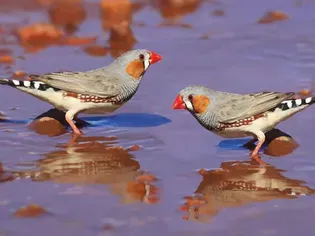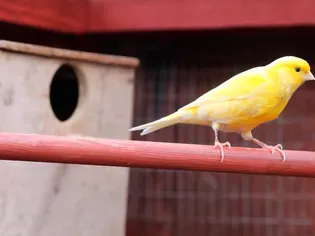Facts About Finches
Updated on 05/27/24

Unveiling the Enchanting World of Finches: A Comprehensive Guide to Their Extraordinary Facts
In the vast avian tapestry, finches stand out as captivating creatures, their vibrant plumage and melodious songs gracing the natural world. This article delves into the fascinating facts about finches, exploring their remarkable adaptations, diverse habitats, intriguing behaviors, and significant ecological roles. Join us on this journey of discovery as we unravel the secrets of these beloved songbirds.
1. Evolutionary Prowess: Darwin's Finches and the Galapagos Legacy
Charles Darwin's observations of finches on the Galapagos Islands revolutionized evolutionary theory. The distinct beak shapes among different finch species, adapted to exploit specific food sources, provided compelling evidence for natural selection. This iconic example showcases the power of adaptation and the extraordinary diversity that can arise from a single ancestral lineage.
2. A Symphony of Songs: The Musical Masterpieces of Finches
Finches are renowned for their melodious songs, which play a crucial role in courtship, territory defense, and communication. Each species possesses a unique repertoire of songs, often characterized by complex and enchanting melodies. The songs of zebra finches, in particular, have been extensively studied, providing insights into the neural mechanisms underlying vocal learning.
3. The Art of Nest Building: Architectural Marvels in the Finch World
Finches construct intricate nests using a variety of materials, including twigs, grasses, and feathers. These nests provide shelter and protection for the eggs and hatchlings. The nest-building behavior of finches varies greatly among species, ranging from simple cup-shaped structures to elaborate domed or pendant nests.
4. Social Dynamics: From Solitary Living to Cooperative Colonies
Finches exhibit a wide range of social behaviors. Some species, such as the house finch, live in loose colonies, while others, like the purple finch, prefer a more solitary existence. Cooperative breeding, where multiple individuals assist in raising the young, has also been observed in certain finch species, such as the sociable weaver.
5. Dietary Adaptations: A Culinary Journey Through Finch Habitats
Finches have adapted to a diverse range of habitats and food sources. Their beaks, varying in shape and size, are specialized for extracting seeds, fruits, insects, and even nectar. The goldfinch, for instance, possesses a slender beak ideal for extracting seeds from sunflower heads, while the crossbill's crossed mandibles allow it to access seeds from pine cones.
6. Migration Patterns: Navigating the Skies with Precision
Many finch species are migratory, undertaking remarkable journeys to find suitable wintering grounds. Some species, such as the dark-eyed junco, migrate over vast distances, traversing thousands of kilometers with astonishing navigational precision. Others, like the goldfinch, exhibit partial migration, with some populations undertaking long-distance movements while others remain sedentary.
7. Conservation Concerns: Protecting the Future of Finches
Finches face a range of conservation challenges, including habitat loss, climate change, and competition with invasive species. Preserving their habitats, promoting sustainable practices, and addressing climate change are crucial steps in ensuring the long-term survival of these beloved birds.
8. Cultural Significance: Finches in Art, Literature, and Folklore
Finches have captivated human imagination for centuries, inspiring works of art, literature, and folklore. The goldfinch has been a popular subject in European art since the Renaissance, symbolizing joy and purity. In Chinese culture, the red-billed leiothrix is associated with prosperity and good fortune.
9. Ecological Importance: Finches as Key Players in Ecosystems
Finches play significant ecological roles in their respective habitats. They are important seed dispersers, contributing to plant diversity and forest regeneration. Their consumption of insects helps control populations of these potential pests. Additionally, finches serve as prey for larger birds of prey, maintaining a delicate balance in the ecosystem.
10. Domestication and Human Interactions:
Some finch species, such as the zebra finch and the canary, have been domesticated and kept as pets. These birds are popular for their attractive coloration, lively personalities, and melodious songs. However, it is essential to provide appropriate care and ensure that their welfare is prioritized in captivity.
Conclusion:
The world of finches is a captivating and diverse tapestry of avian wonders. From their remarkable evolutionary adaptations to their intricate songs, fascinating nesting behaviors, and ecological importance, these birds continue to inspire and intrigue bird enthusiasts around the globe. By understanding and appreciating the extraordinary facts about finches, we can better appreciate their beauty, protect their habitats, and ensure their continued presence in the natural world.
Explore More Pets

Small Bird Breeds
Gloster Canary: Bird Species Profile

Small Bird Breeds
Java Finch: Bird Species Profile

Small Bird Breeds
Zebra Finch (Chestnut-Eared Finch): Bird Species Profile

Small Bird Breeds
Alexandrine Parakeet: Species Characteristics & Care

Small Bird Breeds
Canary: Bird Species Profile

Small Bird Breeds
Lovebird (Pocket Parrot) Species Profile

Small Bird Breeds
A Guide to Pet Budgie Birds

Small Bird Breeds
Types of Small Parrots
